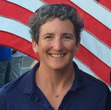Carol Newman Cronin's Blog, page 3
May 8, 2025
Getting “Real” with Wingfoiling
A few weeks ago, Paul and I drove down to the Outer Banks of North Carolina for our first-ever wingfoiling-dedicated vacation. Known as “Hatteras” to the wind-sports community, our actual destination was Real Watersports. To non-sailors, I would describe it as an all-inclusive resort for water-based board sports—anything that doesn’t require more than a few feet of water to launch.
To anyone who has already discovered the addictive qualities of winging or kiting, I would simply call it “Mecca.”

We stayed at the Watermen’s Retreat, the white building on the left side of the photo. And since it was shoulder season, we were able to book a room (circled in red) with a balcony view of all activities, on and off the water. Every day we fit in two sessions, with a lunch break in between. Thanks to both the Watermen’s Grill and a great kitchen in the apartment, we never had to leave the property to eat well—and, even when we chose to share meals with new friends, we never had to talk about anything besides watersports.
The entire location is set up for easy water access. There’s a large grassy area for rigging, with plenty of sand bags to weigh down inflated wings. A hose to rinse everything, right next to a work table with tools. There’s even a large drying rack for wetsuits—though some looked like they’d been abandoned. The room rental includes a storage locker, where wet gear could dry out overnight; that kept us from tracking brackish water upstairs, a perfect example of Real’s carefully thought-out win-wins.
Oh, and did I mention the store? Though the entrance is crowded with generic beach-oriented softgoods, the back and upstairs areas had everything we could possibly need to improve our time on the water—including the entire range of Armstrong foils. When we decided during a lunch break to downsize our tails, all I had to do was walk upstairs and announce to a salesperson that “I need two Speed 180s.” (There was absolutely no judgment about whether that should’ve been “need” or “want.”)
Of course even the nice folks at Real can’t guarantee wind, but we happened to choose a week with breeze every single day—and two red-letter days when smaller, easier to handle wings provided plenty of power.
After sailing, whether we chose the privacy of dinner on our own balcony or joining new friends at the restaurant, we enjoyed watching the many local families who showed up to enjoy the sunset: kids running around, footballs tossed between siblings or friends, parents chatting. And unlike other resorts, the crowd disappeared as soon as the sun did—so those of us tuckered out from a great day on the water could go to bed as early as we wanted.
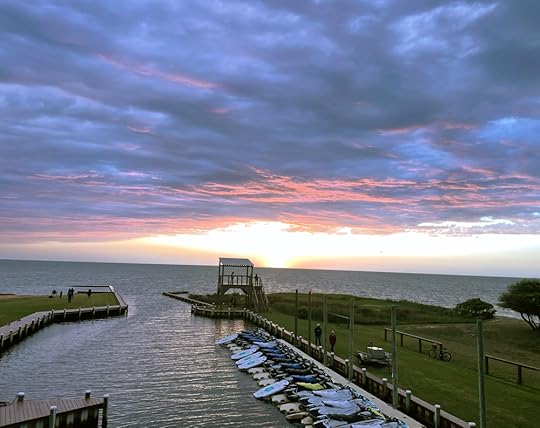
Real Watersports rents gear and gives lessons, so it’s a great place to build skills at any level. One caution, though: foilers will need a short mast (the vertical piece that attaches to the board) unless they also get lucky with a southerly breeze. We had a northerly the last day, and it was amazing how fast the water level dropped a crucial foot or more. That morning, we had to walk our tall masts out a quarter mile before we could get going without touching bottom. By the afternoon session, that no-go line had moved out another 100 yards—and staying up on foil was a high priority, even well offshore.
Want to learn to wingfoil this year? Real’s tagline is “We make new riders every day.” After listening in as their instructors motivate and inspire, I’m a believer—and I can’t wait to go back.
The post Getting “Real” with Wingfoiling appeared first on Carol Newman Cronin.
May 1, 2025
The Unique Joy of a Well-Designed Book
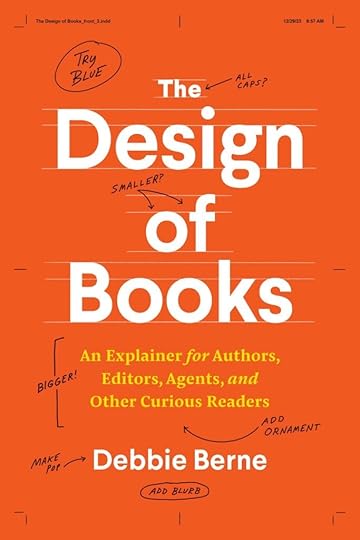
Over the winter, my sister-in-law (also a writer) loaned me The Design of Books: An Explainer for Authors, Editors, Agents, and Other Curious Readers, by Debbie Berne. After racing through it, impressed by the way it visually proved each point through its own deceptively simple design, I immediately bought my own copy—and have referred to it frequently over the past few months, as I work with the designer to lay out the Hound book.
As Berne points out, the best book design blends into the background, unnoticed by most readers. Here’s an excerpt from the first chapter:
Words MatterA book page is so familiar, and seemingly so straightforward, there may not seem much for a designer to do. But a lot of thinking goes into even the most basic page of text. The work is labor-intensive, fussy, hidden, and yet transformative . . . When this is done well, the mechanics of the writing and the design virtually disappear.”
Naturally, over the centuries, book designers have developed their own language (just like sailors). This book defines several terms that I’d never really understood. In book-speak, what I think of as “a book” is properly called a codex: to distinguish it from a tablet or scroll. There’s a reason this structure has stood the test of time, says Berne. “A codex is handy, sturdy, and easy to use. It allows for random access—you can open it to any part—in contrast to scrolls, which much be unwound and sifted through sequentially. Pages can be printed on both sides, creating efficiency in their manufacture and their use.”
Another favorite bookish term is now “folio,” which sounds so much more impressive than “page number.” That is not to be confused with “spread,” which is both of the folios you see when the book lies open. There are also running feet, running heads, and even running shoulders; all help form that “unseen” structure that guides our eyes across each page.
Joys and PitfallsBut this book is far more than just a dictionary. Berne has worked with both traditional and self-published authors, and she shares both the joy and potential pitfalls of that inevitable moment when lofty ideas first meet on-page reality. Under Sample Design, a term she calls “vanilla” for “what may be the hardest and most important (and most exciting) phase of book design,” she explains:
“Design brings shape, structure, and pacing to a project. It’s not unusual for authors to tell me that everything became so much clearer once they saw some portion of their manuscript in designed spreads. ‘Ah! That’s what I’ve been doing!’ Design can illuminate the relationship (or, at least, one possible relationship) between words and images that authors have suspected but haven’t been quite able to grasp.”
Berne also points out something that definitely hit home with this author: Editors “worry that authors can’t stop revising, and some can’t.”
No MicromanagingFor me, the most valuable part of the book was some firm direction on how to provide feedback. It’s advice that could be applied to any working relationship, but it really helped me communicate more efficiently with the designer. The two most important points were:
1. “If there are aspects you think you don’t like or may want changes, start by asking the designer WHY they made the choices they did.” (Emphasis mine.)
2. Focus on overall impact. “Know that the details will be worked out in the designing and should not be overdetermined or micromanaged. I can’t say it enough times: leave the designing to the designers.”
More than a ManualThroughout the book, Berne’s humor and knowledge weave together into another unseen feature of the best books: a distinctive voice. Combined with the deceptively simple layout, her creation became for me much more than just another how-to: reading it actually quieted my brain. It was a comforting reassurance that there is structure in the world—at least the one that lies between these orange covers.
Some books find us at exactly the right time, and thanks to the The Design of Books I now understand why the Hound book designer wanted to design the cover before the interior (sorry). So thanks to Debbie Berne for putting together what she calls “a book that is accessible and useful (and even a little bit fun),” an invaluable addition to my library as both a calming and comprehensive guide—just in time to make an “unseen” difference to my next book.
Also thanks to my sister-in-law for loaning out her copy!
Got a question about book-building? Add it to the comments below, or send me an email. I read every single one, with gratitude—and I’m so glad you’re here.
The post The Unique Joy of a Well-Designed Book appeared first on Carol Newman Cronin.
April 24, 2025
Mike Toppa: Superior Team Building, with a Smile
The first issue of Sailing World for 2025 includes an article I originally titled “Reading the Room.” Mike Toppa has been sailing with clients (and on his own) for more than five decades; when I interviewed him for Seahorse, he claimed he’s only ever had one job.
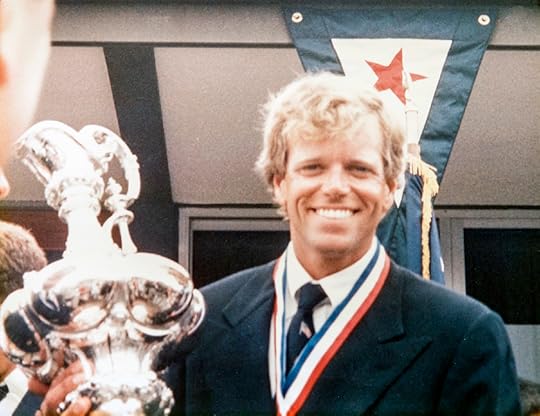
After finally getting the chance to share a cockpit with him onboard Hound last summer, I wanted to interview him all over again. This time, I wanted to puzzle out how he manages to improve teams, even when he’s stepping onboard for the first time—and even if it’s just for a casual weekend regatta. Hence the editor’s preferred title, which is probably much more informative: “The Art of the Crew Boss.”
Sailing World has given me permission to share the PDF with all of you, but to see what else they’ve packed into the spring issue you’ll have to subscribe. That will obviously help keep a great magazine going, which will give me an excuse to keep interviewing sailors I admire. But it will also give you insights from their other experts, too—even those who aren’t talking about “reading the room.”
Got a sailing expert you want to learn more about? Leave their name(s) in the comments below, or send me an email. I appreciate any and all suggestions. And thanks for reading! So glad you’re here.
Read The Art of the Crew Boss (Sailing World)
Read Toppa Talks: One Job, One (Big) Dream (Seahorse)
The post Mike Toppa: Superior Team Building, with a Smile appeared first on Carol Newman Cronin.
April 17, 2025
The FAQs and NBAQs of Great Presentations
Every time I give an organized talk about books and boats, at least one follow-up question comes as a complete surprise. You could blame that on “insufficiently prepared,” but I prefer to think that my presentation accomplished its most important goal: to inspire fresh thoughts.
A few weeks ago, a lively crowd showed up at the Cape Cod Maritime Museum for “From Fact to Fiction, and Back Again.” It was mostly strangers, with a smattering of old friends—and all paid close attention to examples of how personal history can inspire fiction (and vice versa).
 Photo courtesy Paul Cronin Studios
Photo courtesy Paul Cronin StudiosUsually no one wants to be the first to ask a question. But before the applause even had a chance to die down, a hand shot up—and our robust Q and A lasted almost as long as my prepared talk. (You could call this another Cape Cod Surprise!)
I have to admit, there’s a list of questions I’ve learned to expect at such events—including, but not limited to, these three:
FAQs1. Where do you get your ideas? (The best ones actually “get” me.)
2. Did you meet your husband at the Olympics? (No, we met at Sail Newport.)
3. What was the Olympics like? (I tried to answer that one here.)
NBAQsOn that particular evening, though, none of these came up; instead I had to sputter out answers to Never Before Asked Questions (NBAQs). Looking back, I could’ve come up with stronger responses . . . but here’s what I said in the heat of the moment to the four questions I remember best.
1. What was the scariest moment you ever had on a boat? (The No Good, Very Bad Windiest Day)
2. What surprised you most at the Olympics? (All those pesky details.)
3. What was your longest sail? (21 day transatlantic)
And, most difficult of all:
4. What would be the best boat to sail across Buzzards Bay?
That one stumped me, because it’s what I call a “how long is a piece of string” question: not enough information to make an educated answer. Boat choice is personal—and safe voyages of any distance are extremely weather-dependent. But without going into all that, I tried to explain the need for a stable and large enough platform; hoping to encourage, without implying that I was at all the right person to make such an important decision for anyone else.
Like any book or article, I always have more to say than can possibly fit into one presentation. That’s why I really enjoy the Q and A afterward; it teaches me what one particularly curious audience would’ve liked to hear more about. Especially when they provide their very own Cape Cod Surprise with such an enthusiastic stream of NBAQs.
Got a question I haven’t yet answered here on the blog? Ask it in the comments below, or send me an email. I read every single one, with gratitude. And if you’re looking for a speaker for your next book– or boat–centric gathering, please get in touch.
Thanks for being here!
The post The FAQs and NBAQs of Great Presentations appeared first on Carol Newman Cronin.
April 10, 2025
Why I Believe in Boats
Eight years ago, I started a blog post entitled Why I Believe in Boats. For some reason, I never took the time to polish it into a publishable piece—but I also didn’t throw it out. When I stumbled onto it again just a few days ago, it seemed like a reminder we could all use right about now. So here it is, at last; enjoy!
Whenever I push away from the shore, I take control of my own destiny. Any watercraft will do, but it’s vessels propelled by the wind that have taught me the most about life’s most valuable balancing acts: the need for both preparation and improvisation, confidence and humility. The importance of patience, self-reliance, communication. And, of course, vectors.

Just after college, a 21-day transatlantic taught me that all the spare parts in the world won’t fend off a storm. Almost twenty years later, I brought those life lessons to the 2004 Olympics and won two races. (I also ate a lot of humble pie on the no good, very bad, windiest day.)
Boats teach patience. When the sea breeze fades off to nothing during a summer evening sail, I might get back to shore after sunset—and that’s just fine.
Boats teach us to chart our own path. Even navigating a lowly paddleboard along a familiar shoreline feels like forging a brand-new, self-determined course.
Boats require a specialized language that spans both generations and cultures. For those of us who speak sailing, it can be enough to bridge even seemingly insurmountable communication gaps.
As for vectors: Wanting to understand my own 3D observations about crossing a moving carpet of current inspired me to pay better attention in geometry class. Though I’m still much better with the practical than the theoretical.
Whether celebrating, sulking, or stewing, I always escape to the water—where a view of the horizon, combined with a basic belief in my own abilities, helps me navigate back onto an even keel.
I believe in boats, because getting out on the water helps us better navigate life and all of its transitions. All we really need is the courage to push away from the shore.
Thanks for reading, and maybe this post will inspire you to publish something long neglected!
The post Why I Believe in Boats appeared first on Carol Newman Cronin.
April 3, 2025
Climbing (Virtual and Actual) Mountains with a Health Coach
When I interviewed Heidi Doyle back in 2019, she was busy creating a healthy and supportive atmosphere at Island Heron Yoga here in Jamestown (read Heidi Doyle: Going with the Yoga Flow). A year later, she turned over the studio to a new owner—though she continues to both teach and inspire.
A few weeks ago, I spotted a poster for Thrive, Heidi’s new health coaching business—which made me curious enough to ask for another interview. As soon as we sit down in the cozy front room at the Island Heron, I realize: now anyone, anywhere, can soak up both her holistic health tips and her calm, community-oriented approach.
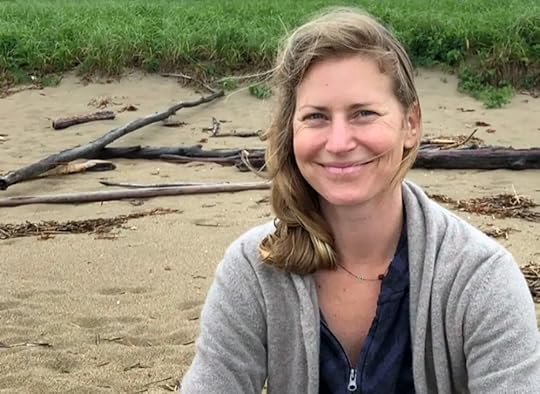
Last year, Heidi earned a degree from the Institute for Integrated Nutrition (IIN). The program is taught by functional medicine doctors who focus on cellular health, well-being, and understanding the root cause of diseases—not just masking symptoms. “So you can see why it can take some time to peel the layers back,” Heidi says.
We all know we should eat good food, exercise, sleep well, and manage stress, she continues. “It seems so simple—so why is it so elusive to put into practice? Because we’ve all developed habits, conscious and unconscious, and we don’t necessarily inquire why we do things.”
To learn what troubles each potential client about their health, Heidi offers a free introductory call. “Then I explain the process, which empowers you to become an expert on you.” At that point, she says clients often realize, “this is what I need to do.” Then, over the next six months, they meet every two weeks to work step by step toward better health. “Each session, we identify action items for the next two weeks. The approach is slow, steady transformation—not temporary change.”
When I ask if her current clients share any common goals, she shakes her head at first; “It’s so individual.” But then she shares one link. “Right now, I’m working with three people all motivated by the desire to improve their health in order to hike a mountain—all on different continents. Cool, huh?”
Heidi says this new expertise complements the way she’s always taught yoga. ‘In my classes I guide people to pay attention, to trust their own unique process, and approach it all in a balanced way. It’s the same for health coaching.”
After just one year of coaching, “I have already learned so much—but I’m humbled by how much there still is to learn.”
And she really enjoys helping clients navigate up their personal mountain (whether virtual or actual). “Everything I’ve been interested in has merged in this process, and I feel so grateful to be able to share and help others.”
I’m so grateful to Heidi for everything she’s taught me—and now, wherever you are and whatever your health goals—you can learn from her too. For more info, visit the Thrive website.
Thanks for reading! Have you tried yoga, or health coaching? Share your experience in the comments below, or send me an email. I read every single one, with gratitude.
(And if you’re wondering how I can possibly justify covering such topics on Where Books Meet Boats, read on.)
Related PostsSUP Yoga: Cross Training to a New Perspective
My Best Summer Joy for 2022: A Stable “Platform”
Leaving Our Comfort Zone: 3 Things
The post Climbing (Virtual and Actual) Mountains with a Health Coach appeared first on Carol Newman Cronin.
March 27, 2025
5 Lessons from Messing About in Boats
Last week, I had a fun chat with the collections and exhibit manager at the Cape Cod Maritime Museum. Her goal was an oral history that will be added to an exhibit about the history of sailing on Cape Cod; my goal was to finalize a talk I’ll be giving at the museum on April 3rd. Somewhere along the way, it turned into a fun reminder of some childhood lessons that helped turn me into the sailor and human I am today.
 1. Don’t cut it too close
1. Don’t cut it too closeI don’t really remember learning to sail; it was just something my siblings and I absorbed as soon as we were physically ready to do so. Most lessons about boathandling and maintenance came from my dad, but I do remember once steering the family’s skiff (with its recently added outboard) across the bow of another moving boat—and my only passenger (Mom) instructing me not to cut anyone off like that, ever again.
2. Crossing or ducking? It mattersThe summer I was 10, Bobby Bigelow introduced me to one-design sailing—and I crewed (and later skippered) his Cape Cod Knockabout throughout my teens. Maybe it wasn’t on my very first Knockabout race, but that first summer there was an early lightbulb moment: Bobby pointed to a competitor forced to duck our stern, explaining that we had gained on them since the last time we ducked them. It was my first conscious lesson in the tactics of racing small boats.
3. Get better as a teamBobby didn’t actively teach; he just casually shared his decisions with a fairly constant running commentary. After racing, we’d often discuss situations that were unclear at the time; the focus didn’t seem to be on teaching me (the youngster), but on all of us learning to do better together.
4. Cooperative competitionAny time there was conflict on the race course, Bobby would approach the other skipper afterward to talk it through. 50 years later, that’s still part of my post-race habits.
5. Let them learnNow that I’ve watched others grow up within the Snipe family, I understand just how much patience my early mentors must’ve had. But letting me make my own mistakes taught me better than any upfront warnings would’ve done—another lesson in itself.
Being asked for an oral history makes me feel old—but it also was a very fun excuse to relive several wonderful childhood memories. Got your own memories from growing up sailing on Cape Cod? Share them in the comments below, and maybe I’ll incorporate them into next week’s presentation. Thanks for reading!
PS If you want to join the History on Tap fun at the museum next week, here’s how to register.
The post 5 Lessons from Messing About in Boats appeared first on Carol Newman Cronin.
March 20, 2025
Ebook Update: Now You Can Support Your Local Indie
Over the years, I’ve gotten used to buying new books without actually leaving the house—and, especially when opting for an ebook, simultaneously checking off “instant gratification.” Now, thanks to upgrades at bookshop.org, even when buying a digital copy I can support my local independent bookstore.

Ever since ebooks first appeared two decades ago, independent bookstores could not navigate the technical twists and turns of selling digital copies. I won’t bore you with the details, but it’s a huge relief that a company dedicated to supporting indies has finally managed to overcome all those obstructions. Now, even if you prefer the convenience of instant delivery and reading on a screen, you can still send the profits of your purchases to whatever store you choose.
In today’s era of impersonal big tech, I’m psyched to support cozy bookstores like Island Books and Charter Books (instead of an oligarch) without sacrificing the instant gratification and convenience of downloading a story. Though I still love reading best on paper, it’s nice to know that choosing an ebook won’t punish my favorite book support systems.
There is just one downside; I may never leave the house.
Got a preferred book-browsing and/or buying approach? Share it in the comments below, or send me an email. I read every single one, with gratitude. Thanks for being here, and see you next week.
The post Ebook Update: Now You Can Support Your Local Indie appeared first on Carol Newman Cronin.
March 13, 2025
Seahorse Profile: Sharing a Brain
Welcome to my 20th profile for Seahorse Magazine! I am fascinated by how great names in sailing got to be so impressive, which is why these interviews are so much fun for me. This chat was with Robbie Doyle, the founder of one of our sport’s best-known brands—and luckily I also got to hear from his wife and former business partner. Along with lunch, Janet provided two very valuable items during our wide-ranging conversation: context and fact-checking. After 52 years of marriage, she says that “together, we have one brain.”

Also in the March issue of Seahorse are Paul Cayard’s thoughts about an All-American cross-country road trip; driving a Star boat almost non-stop from San Diego to Miami, with his son. He claims such experiences are helping to make him (in his own estimation) the richest man in the world… so you might want to subscribe.
Profile #21 is already in the publishing pipeline, and I promise it’s another “great” in the sailing world. Meanwhile, let me know what you think of this one by adding a comment below or sending me an email. I read every single one—and together, they might just help make me the richest woman in the world.
Thanks for reading, and see you next week.
Read Forward Towards the Unknown
Previous Seahorse ProfilesPaul Callahan: Maximizing His Unique Potential
Giving Paul Bieker Some Seahorse Love
Betsy Alison: Using All the Tools
Jerry Kirby: All the Stories are True
Peter Harken: What an Amazing Guy
Buddy Melges: He Really Was a Wizard
Toppa Talks: One Job, One (Big) Dream
Circus Minimus: The Rich Life of Bill Mattison
Mark Reynolds: Hard Chines and Unasked Questions
Dawn Riley: Setting the Standard
Clicks of Chance: Onne van der Wal
Just Say Yes: Stan and Sally Honey
Rod Davis: Why You Need His Wisdom in 2021
Rod Johnstone: An Amazing Legacy of Yacht Designs
A Final Conversation with Harry Anderson
Vince Brun Profile in Seahorse
The post Seahorse Profile: Sharing a Brain appeared first on Carol Newman Cronin.
March 6, 2025
The Pleasurable Pause of Winter in Jamestown
I live on an island. Yes, it’s connected by bridges (as well as a ferry), but it still feels both insulated and isolated from the rest of the world. Especially this time of year, when license plates are all local and summer houses stand empty.

While I completely understand the appeal of escaping New England winter, I also appreciate the unspoken community of our increasingly short off-season. Toughing it out here at home creates a sense of “locals only;” a shared understanding that we’re all in this together.
Most communities are built around a common passion, but this one is built on geography; an irrational sense that it’s different here from anywhere else. We feel like we automatically have something in common with others who are also somehow finding a way to stay warm and motivated until spring finally arrives, no matter what we’re each thinking about what’s happening out in the wider world. And thanks to our unpredictable New England weather, we always have a neutral topic to start off those wonderful offhand chats at the grocery or hardware store. Such “Jamestown moments” are sure to chase away any winter blues.
While I’m extremely grateful for the digital link this blog provides to book and boat lovers around the world, it will never replace the far more analog connections of interacting with my fellow islanders. Community matters—especially right now, when it’s so easy to feel more isolated than insulated by the storm waters lapping at our shores.
So, before the out-of-town license plates fill up the island again, let’s all pause to savor the joys of getting through the winter in a small town. And if you’ve had an unexpected interaction that helped fend off the winter blues, please share it in the comments below or send me an email. I read every single one, with a boatload of digital gratitude.
The post The Pleasurable Pause of Winter in Jamestown appeared first on Carol Newman Cronin.

